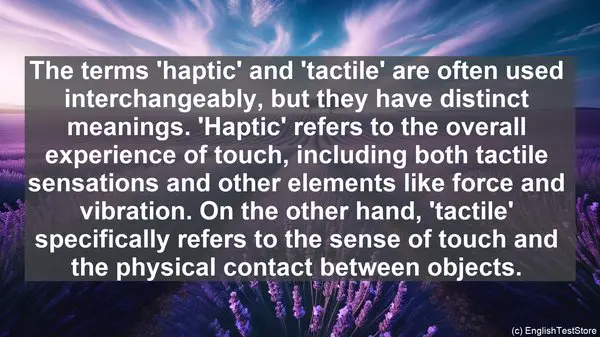Introduction to Haptics
Welcome to our haptics lesson. Haptics is the science of touch and tactile feedback. It plays a crucial role in various fields, including virtual reality, robotics, and medical simulations. Today, we’ll focus on some words that often cause confusion in the haptics community.

1. Haptic vs. Tactile
The terms ‘haptic’ and ‘tactile’ are often used interchangeably, but they have distinct meanings. ‘Haptic’ refers to the overall experience of touch, including both tactile sensations and other elements like force and vibration. On the other hand, ‘tactile’ specifically refers to the sense of touch and the physical contact between objects.
2. Vibrotactile vs. Tactile
Similar to the previous pair, ‘vibrotactile’ and ‘tactile’ have subtle differences. ‘Tactile’ refers to any touch-related sensation, while ‘vibrotactile’ specifically refers to the perception of vibrations on the skin. For example, a phone’s vibration alert is a vibrotactile feedback.
3. Haptic Feedback vs. Haptic Interface
These terms are often used in the context of user interactions with technology. ‘Haptic feedback’ refers to the tactile response a user receives from a device, like the vibration when typing on a smartphone. On the other hand, a ‘haptic interface’ is a physical or virtual system that enables users to interact with a digital environment through touch.
4. Tacton vs. Haptic
While both ‘tacton’ and ‘haptic’ relate to touch, they have different applications. ‘Tacton’ is a term used in marketing and product design to describe the touch-related qualities of a product, like its texture or feel. ‘Haptic,’ as we discussed earlier, is more comprehensive and encompasses various touch-related aspects.
5. Kinesthetic vs. Haptic
These terms are often used in the context of virtual reality and simulations. ‘Kinesthetic’ refers to the sense of body movement and position, while ‘haptic’ encompasses the broader touch-related experiences. For example, a haptic feedback system in a VR game can provide both tactile sensations and a sense of body movement.
6. Haptic Actuator vs. Haptic Sensor
In haptic systems, actuators and sensors are crucial components. An ‘actuator’ is a device that generates physical feedback, like vibrations or forces, to the user. On the other hand, a ‘sensor’ is used to detect and measure touch-related inputs, such as pressure or position.
7. Haptic Rendering vs. Haptic Rendering
These terms are often used in the context of virtual reality and simulations. ‘Haptic rendering’ refers to the process of generating and displaying haptic feedback in a virtual environment. On the other hand, ‘haptic rendering’ is the perception and interpretation of the rendered haptic feedback by the user.
8. Haptic Texture vs. Tactile Texture
When it comes to describing the texture of a surface, both ‘haptic texture’ and ‘tactile texture’ are used. ‘Haptic texture’ refers to the perception of texture through touch, while ‘tactile texture’ specifically refers to the physical properties of the surface that contribute to its texture.
9. Haptic Signal vs. Tactile Signal
In the context of communication systems, ‘haptic signal’ and ‘tactile signal’ are used. ‘Haptic signal’ refers to any touch-related signal, while ‘tactile signal’ specifically refers to signals that convey information through touch, like Morse code through vibrations.

10. Haptic Perception vs. Tactile Perception
Both ‘haptic perception’ and ‘tactile perception’ refer to the understanding and interpretation of touch-related stimuli. However, ‘haptic perception’ is a broader term that includes not only tactile sensations but also other elements like force and temperature, while ‘tactile perception’ focuses solely on the sense of touch.
